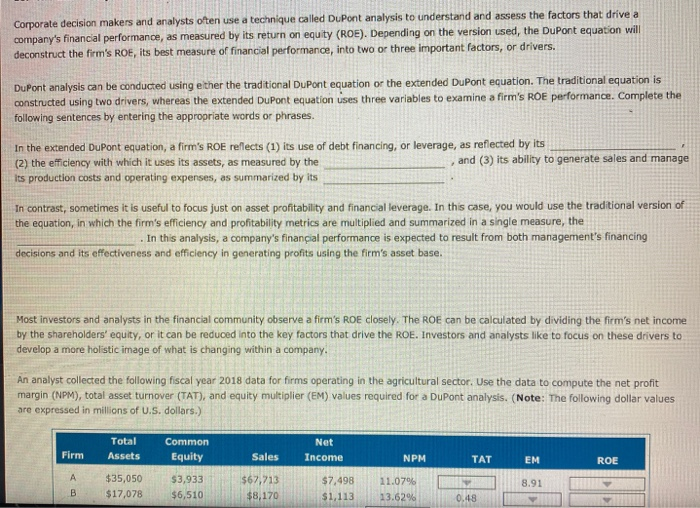Corporate decision makers and analysts often use a technique called DuPont analysis to understand and assess the factors that drive a company's financial performance, as measured by its return on equity (ROE). Depending on the version used, the DuPont equation will deconstruct the firm's ROE, its best measure of financial performance, into two or three important factors, or drivers. DuPont analysis can be conducted using either the traditional DuPont equation or the extended DuPont equation. The traditional equation is constructed using two drivers, whereas the extended DuPont equation uses three variables to examine a firm's ROE performance. Complete the following sentences by entering the appropriate words or phrases. In the extended DuPont equation, a firm's ROE reflects (1) its use of debt financing, or leverage, as reflected by its (2) the efficiency with which it uses its assets, as measured by the , and (3) its ability to generate sales and manage its production costs and operating expenses, as summarized by its In contrast, sometimes it is useful to focus just on asset profitability and financial leverage. In this case, you would use the traditional version of the equation, in which the firm's efficiency and profitability metrics are multiplied and summarized in a single measure, the In this analysis, a company's financial performance is expected to result from both management's financing decisions and its effectiveness and efficiency in generating profits using the firm's asset base. Most investors and analysts in the financial community observe a firm's ROE closely. The ROE can be calculated by dividing the firm's net income by the shareholders' equity, or it can be reduced into the key factors that drive the ROE. Investors and analysts like to focus on these drivers to develop a more holistic image of what is changing within a company. An analyst collected the following fiscal year 2018 data for firms operating in the agricultural sector. Use the data to compute the net profit margin (NPM), total asset turnover (TAT), and equity multiplier (EM) values required for a DuPont analysis. (Note: The following dollar values are expressed in millions of U.S. dollars.) Total Assets Common Equity Firm Net Income Sales NPM TAT EM ROE A $35,050 $17,078 $3,933 $6,510 8.91 $67,713 $8,170 B $7,498 $1,113 11.07% 13.62% 0.48 Corporate decision makers and analysts often use a technique called DuPont analysis to understand and assess the factors that drive a company's financial performance, as measured by its return on equity (ROE). Depending on the version used, the DuPont equation will deconstruct the firm's ROE, its best measure of financial performance, into two or three important factors, or drivers. DuPont analysis can be conducted using either the traditional DuPont equation or the extended DuPont equation. The traditional equation is constructed using two drivers, whereas the extended DuPont equation uses three variables to examine a firm's ROE performance. Complete the following sentences by entering the appropriate words or phrases. In the extended DuPont equation, a firm's ROE reflects (1) its use of debt financing, or leverage, as reflected by its (2) the efficiency with which it uses its assets, as measured by the , and (3) its ability to generate sales and manage its production costs and operating expenses, as summarized by its In contrast, sometimes it is useful to focus just on asset profitability and financial leverage. In this case, you would use the traditional version of the equation, in which the firm's efficiency and profitability metrics are multiplied and summarized in a single measure, the In this analysis, a company's financial performance is expected to result from both management's financing decisions and its effectiveness and efficiency in generating profits using the firm's asset base. Most investors and analysts in the financial community observe a firm's ROE closely. The ROE can be calculated by dividing the firm's net income by the shareholders' equity, or it can be reduced into the key factors that drive the ROE. Investors and analysts like to focus on these drivers to develop a more holistic image of what is changing within a company. An analyst collected the following fiscal year 2018 data for firms operating in the agricultural sector. Use the data to compute the net profit margin (NPM), total asset turnover (TAT), and equity multiplier (EM) values required for a DuPont analysis. (Note: The following dollar values are expressed in millions of U.S. dollars.) Total Assets Common Equity Firm Net Income Sales NPM TAT EM ROE A $35,050 $17,078 $3,933 $6,510 8.91 $67,713 $8,170 B $7,498 $1,113 11.07% 13.62% 0.48







